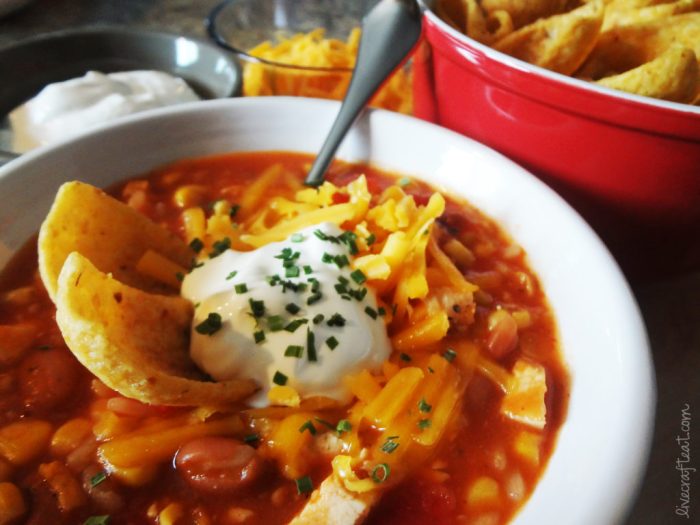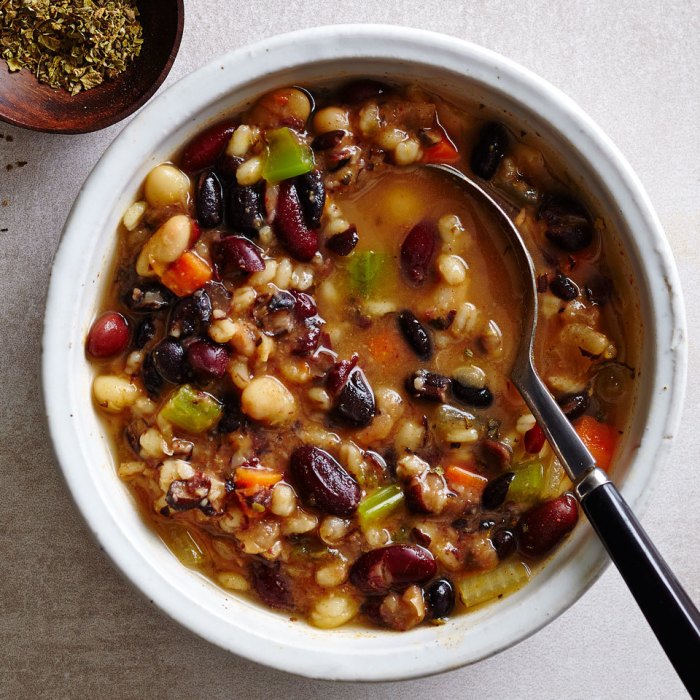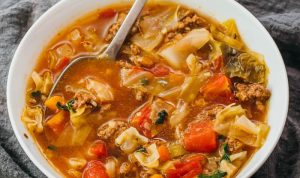Southwestern Soup: A Culinary Journey
Southwestern soup recipe – Southwestern cuisine, a vibrant tapestry woven from Native American, Spanish, Mexican, and American influences, offers a diverse range of flavors and ingredients. This exploration delves into the heart of Southwestern soups, uncovering their rich history, diverse variations, and the secrets to crafting a perfect bowl.
Defining Southwestern Cuisine
Southwestern cuisine is characterized by its bold flavors, a blend of spicy and savory notes, and the prominent use of fresh, locally sourced ingredients. The region’s arid climate influences the types of produce that thrive, resulting in a reliance on chiles, beans, corn, squash, and various herbs and spices. Historically, Southwestern cooking reflects a fascinating fusion of cultures.
Native American traditions laid the foundation, utilizing indigenous ingredients and cooking techniques. Spanish colonization introduced new ingredients like cattle and various spices, while Mexican influences brought the richness of chili peppers and diverse bean varieties. The 20th century saw further evolution, with American culinary innovations adapting and blending these existing traditions.
Essential Southwestern Spices
| Name | Description | Flavor Profile | Typical Uses |
|---|---|---|---|
| Chili Powder | A blend of ground chiles, often including ancho, pasilla, and cayenne. | Spicy, smoky, earthy | Soups, stews, chili, rubs for meats |
| Cumin | A warm, earthy spice with a slightly bitter note. | Warm, earthy, slightly bitter | Chili, tacos, stews, soups |
| Oregano | A pungent herb with a slightly bitter and sweet taste. | Earthy, slightly sweet and bitter | Mexican dishes, soups, stews |
| Cayenne Pepper | A finely ground chili pepper with intense heat. | Fiery, hot | Soups, chili, sauces, as a seasoning |
Soup Variations in Southwestern Cuisine
Southwestern soups showcase a remarkable diversity, reflecting the region’s rich culinary heritage. They can be broadly categorized by their primary ingredients: bean soups (like black bean soup or pinto bean soup), corn soups (such as creamy corn chowder with a Southwestern twist), chicken soups (often featuring tomatillos and chiles), and vegetable soups (incorporating squash, zucchini, and other seasonal vegetables).
Three Distinct Southwestern Soup Recipes
A comparison of three distinct Southwestern soups highlights the culinary range within this style of cooking. A classic Red Chile Chicken Soup features tender chicken, vibrant red chiles, and hominy in a rich broth. Posole, a hearty stew-like soup, showcases hominy, pork (or vegetarian alternatives), and chiles. Finally, a simple yet flavorful Black Bean Soup emphasizes the earthy sweetness of black beans, enhanced by cumin, oregano, and a touch of lime.
- Red Chile Chicken Soup: Characterized by its deep red color and smoky flavor from the chiles, this soup is often thickened with masa harina for a creamy texture.
- Posole: A deeply flavorful and textured soup, Posole can vary in its spiciness and the inclusion of additional ingredients like shredded lettuce, radishes, and onions as toppings.
- Black Bean Soup: A simple yet satisfying soup, the black bean soup’s depth of flavor comes from slow cooking and the addition of aromatic spices.
Broth Types in Southwestern Soups
- Chicken Broth
- Vegetable Broth
- Red Chile Broth
- Beef Broth
Recipe Ingredients and Sourcing

Source: tasteofhome.com
The sourcing and seasonality of key ingredients are crucial to authentic Southwestern soups. Chiles, for instance, are harvested during specific seasons, each variety offering unique flavor profiles. Beans, similarly, have varying harvest times and flavors depending on the variety. Corn, a staple, is widely available, but its sweetness and texture change depending on the type and season.
Sourcing ingredients locally whenever possible ensures freshness and supports regional farmers.
Nutritional Benefits of Southwestern Soup Ingredients
Southwestern soups are often nutritionally dense, packed with vitamins, minerals, and fiber. Beans are excellent sources of protein and fiber, contributing to digestive health. Chiles provide antioxidants and vitamins. Corn offers fiber and carbohydrates. The combination of these ingredients creates a balanced and healthy meal.
Shopping List for Southwestern Soup
This shopping list Artikels the necessary ingredients for a representative Southwestern soup recipe, categorized for ease of shopping.
- Produce: Onions, garlic, chiles (e.g., ancho, pasilla), corn (fresh or frozen), cilantro
- Pantry Staples: Cumin, oregano, chili powder, vegetable broth, beans (e.g., black beans, pinto beans), hominy (optional)
- Meat/Protein: Chicken (optional), pork (optional), or vegetarian substitute
Recipe Preparation and Techniques
The following steps Artikel the preparation of a classic Southwestern chicken and vegetable soup. Alternative cooking methods, such as slow cookers and Instant Pots, can be easily adapted.
- Sauté onions and garlic in olive oil.
- Add chiles and cook until softened.
- Stir in chicken broth, beans, corn, and diced chicken (or vegetarian substitute).
- Simmer until chicken is cooked through and flavors have melded.
- Season with cumin, oregano, chili powder, and salt to taste.
- Garnish with fresh cilantro before serving.
Adjusting Spice Levels and Ingredient Quantities

Source: livecrafteat.com
The spice level of Southwestern soups can be easily adjusted by modifying the amount of chili powder and cayenne pepper. Ingredient quantities can be adapted based on personal preference and the number of servings. For instance, adding more vegetables creates a heartier soup.
Serving and Presentation

Source: media-allrecipes.com
Southwestern soups are best served hot. Accompanying dishes might include cornbread, tortillas, or a simple salad. Garnishes such as fresh cilantro, avocado slices, a dollop of sour cream or Greek yogurt, and a sprinkle of shredded cheese enhance both the visual appeal and flavor.
Visual Description of a Presented Bowl, Southwestern soup recipe
Imagine a rustic bowl brimming with a vibrant red chile chicken soup. The rich, deep red broth is punctuated by the creamy white of hominy, the tender pieces of chicken, and flecks of bright green cilantro. The contrasting colors and textures create a visually appealing and appetizing presentation.
Recipe Variations and Adaptations
Southwestern soups are easily adapted to accommodate dietary restrictions and preferences. Vegetarian or vegan versions can substitute chicken with vegetables or plant-based proteins. Gluten-free options avoid using masa harina or other gluten-containing ingredients. Different meats, beans, and vegetables can be added to create endless variations.
Storing and Reheating Leftovers
Leftover Southwestern soup can be stored in airtight containers in the refrigerator for up to 3 days. Reheating can be done on the stovetop or in the microwave, ensuring the soup is heated thoroughly.
So, I’m experimenting with a hearty southwestern soup recipe, packed with black beans, corn, and a smoky chipotle kick. I was thinking about adding a depth of flavor, and it made me wonder about other unexpected flavor combinations, like those found in recipes with Campbell’s French onion soup – maybe a little French onion base could add a surprising twist to my southwestern creation! Back to my southwestern soup though – I’m thinking a slow simmer is key.
Essential FAQs: Southwestern Soup Recipe
Can I make this soup vegan?
Absolutely! Just swap out any meat or dairy products for vegan alternatives. Think vegetable broth instead of chicken broth, and coconut milk instead of cream.
How long does the soup last in the fridge?
Leftover Southwestern soup is best enjoyed within 3-4 days in the refrigerator. It’s even better the next day, if you can resist it that long!
Can I freeze this soup?
Yes! Freeze in airtight containers for up to 3 months. Let it thaw completely in the refrigerator before reheating.
What if I don’t like spicy food?
No problem! Simply reduce the amount of chili powder or other spicy ingredients to your liking. You can always add more later, but you can’t take it away!






